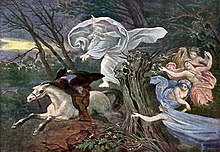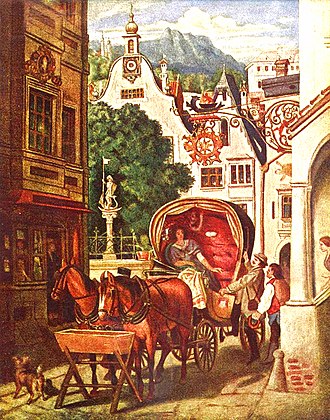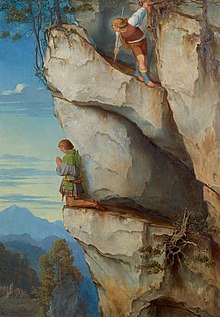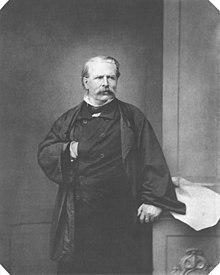Moritz von Schwind



Moritz Ludwig von Schwind (born January 21, 1804 in Vienna , † February 8, 1871 in Niederpöcking , Kingdom of Bavaria ) was an Austrian painter and draftsman of the late Romantic period .
Life
Origin and studies
His parents were Franz Edler von Schwind (1752-1818) and his wife Franziska von Holzmeister (1771-1842), a daughter of Hofrat August Holzmeister von Forstheim (1742-1806), who had been Austrian nobility since 1799, and since 1803 with distinction "From Forstheim". His father came from Bohemia, was court secretary at the secret court chancellery and was made an imperial knight in 1792 . Moritz von Schwind had five brothers, including: the Austro-Hungarian Council of State Baron August von Schwind (1800–1892) and the Bergrat Franz von Schwind (1806–1877). His grandson, the opera singer Wolfgang von Schwind , was the son of Hermann von Schwind.
He first attended the Schottengymnasium in Vienna, where Nikolaus Lenau and Eduard von Bauernfeld were classmates, and then began studying at the university. Actually he should have become a civil servant like his father, but from 1821 he studied with Johann Peter Krafft and Ludwig Ferdinand Schnorr von Carolsfeld at the Academy of Fine Arts Vienna . During his time in Vienna he was friends with Franz Schubert , Franz von Schober , Leopold Kupelwieser and Franz Grillparzer .
Munich
In 1828, on the advice of Peter Cornelius , he moved to Munich , who gave him an order to paint the library room of the Bavarian Queen with scenes from Ludwig Tiecks poetry. After a trip to Italy in 1835, he created designs for the Munich Residence and Hohenschwangau Castle , the latter showing scenes from the life of Charlemagne , implemented by Franz Xaver Glink . Orders from Saxony and Baden followed and made him known.
Karlsruhe and Frankfurt
In the years 1840–1844 Moritz von Schwind lived and worked in Karlsruhe . Here he met his wife Luise Sachs, the daughter of a major. In the well-known picture The Honeymoon , she should be shown. Other sources name Ms. von Mangstl , the opera singer he admires, as a model. In Karlsruhe he created eight round medallions for the conference room of the Karlsruhe State House and decorated the stairwell and the ground floor halls of the State Art Hall with frescoes .
From 1844 to 1847 he worked at the Städelschule in Frankfurt . There he had the Moritz von Schwind House built in the Bockenheimer Anlage in 1845 , a villa of his own design in the form of romantic classicism. The parapet fields are decorated with terracottas of our own design.
Further stations
In 1847 he became a professor at the Academy of Fine Arts in Munich . Teaching assignments in Frankfurt am Main and Munich were followed by Franz von Schober 's commission from the Hereditary Grand Duke of Weimar to paint the restored Wartburg near Eisenach . The murals on the Wartburg, created in 1854/55 - for example the "Singers' War" - are among his most famous works. The paintings show moments from Thuringian history, especially the life of Elisabeth of Thuringia . In 1855 he was knighted together with his brothers August (Ministerialrat) and Franz (Bergrat). He was able to export his cardboard boxes to Glasgow and London.
In 1866/67 he worked on the painting of the newly built Vienna Court Opera in the so-called “Schwind Foyer”. In the loggia there are frescoes by Schwind depicting scenes from Mozart's “Magic Flute” , in the foyer there are frescoes from works by other composers. Schwind's late work, the “Melusinen Cycle”, was intended to decorate a round temple and was completed six months before his death. These pictures are exhibited in the Austrian Gallery.
family
He married Luise Sachs (1816-1894), a daughter of the Baden major Wilhelm Sachs († 1841) and Friederike Elise Weiss, in Beuern near Baden-Baden in 1842 . The couple had a son and five daughters, two of whom died early, but survived:
- Hermann (July 6, 1843 - July 20, 1906) ∞ Karoline Haas (November 5, 1856 - November 1, 1928)
- Anna (1844–1891) ∞ Johann Jacob Siebert, Dr. iur.
- Marie (* 1847) ∞ Ferdinand Baurnfeind (1829–1895), Dr. med.
- Helene (1855–1949) ∞ Paul von Ravenstein (1854–1938), painter, professor
tomb
Moritz Schwind's grave is located in the Old Southern Cemetery in Munich (Gräberfeld 16 - Row 9 - Platz 43/44; ⊙ ).
plant

Moritz von Schwind, who, under the influence of Peter von Cornelius and his monumental style, found a style characterized by generosity and few figures, was next to Carl Spitzweg the most important and most popular painter of the German late Romantic period . His pictures on topics from German sagas and fairy tales are popular and poetic. In addition to oil painting, he also created significant things in fresco painting and book illustration. He also created many templates for the Munich picture sheets . His art, like that of Carl Spitzweg, is nationally limited. In a fire on June 6, 1931 in the Munich Glass Palace , over 3,000 paintings were destroyed during an art exhibition. Among them were works of art by Schwind, u. a. the painting Knight on a Night Voyage from 1851 .
Honors

The Schwindstraße in Frankfurt is named after Moritz von Schwind, just a street of the same name in the district List, the painter district of Hanover , and one is in Munich, Maxvorstadt, in the Academy of Fine Arts. In 1874 the Schwindgasse in Vienna- Wieden (4th district) was named after him. In Niederpöcking there is the Moritz-von-Schwind-Weg . His name was chiseled in his honor at the end of the 1890s on the east side of the Düsseldorf Art Academy , on the right side above the main entrance between Cornelius and Kaulbach . A monument in Vienna created in 1909 by Othmar Schimkowitz was destroyed in 1945 and has not been restored since then. His monument from 1893 on Munich's Praterinsel is to be returned to its old location after the facility was destroyed in World War II.
List of selected works




- The bread cutter ( Österreichische Galerie Belvedere , Vienna), 1823, oil on canvas
- Chivalrous lovers (Wuppertal, Von der Heydt-Museum), around 1824, oil on wood, 40 × 33 cm
- Adam's Sleep (Halle an der Saale, Moritzburg Foundation , Art Museum of the State of Saxony-Anhalt), around 1824, watercolor and pen, heightened with gold, 42.7 × 33.5 cm.
- The Erlkönig ( Österreichische Galerie Belvedere , Vienna), around 1830, oil on panel
- Frescoes in the Munich Residence , 1832–36
- Inauguration of the Freiburg Minster (Karlsruhe, Staatliche Kunsthalle ), 1836–38
- Allegorical frescoes (Vienna, staircase of the Wertheimstein Villa), 1840
- Mermaids watering a deer (Munich, Schack-Galerie ), around 1846, oil on canvas, 69 × 40 cm
- Spielmann und Einsiedler (Munich, Neue Pinakothek ), around 1846, oil on cardboard, 61 × 46 cm
- Rose (Berlin, Nationalgalerie), 1847, oil on canvas, 216 × 137 cm
- The ride of Kunos von Falkenstein (Leipzig, Museum of Fine Arts), around 1850–80, oil on canvas
- Nocturnal duel at a garden gate (Munich, Schack-Galerie), around 1850–60, oil on canvas, 57 × 35 cm
- Symphony (Munich, Neue Pinakothek), 1852, oil on canvas, 166 × 98 cm
- Frescoes on the Wartburg, including Der Sängerkrieg (Wartburg bei Eisenach), 1853–55
- Charlemagne crowned emperor (lithograph 1856, pictures on German history)
- Emperor Rudolf's ride to the grave (Kiel, Kunsthalle), 1857, oil on canvas, 150 × 295 cm
- The Seven Ravens and the Faithful Sister (Weimar), 1857–58, series of watercolors
- The morning hour (Munich, Pinakothek der Moderne, Schack-Galerie), around 1860, oil on wood, 34 × 40 cm
- same subject in a similar design: The Morning Hour , Hessisches Landesmuseum Darmstadt
- Rübezahl (Munich, Schack-Galerie), 1859, oil on canvas
- Farewell at daybreak (Berlin, Nationalgalerie ), 1859, oil on cardboard, 36 × 24 cm
- In the artist's house (Munich, Schack-Galerie ), around 1860, oil on canvas, 71 × 51 cm
- Emperor Maximilian I in Martinswand ( Österreichische Galerie Belvedere , Vienna), around 1860, oil on canvas
- Apse frescoes and stations of the cross (parish church St. Nikolaus, Bad Reichenhall ), 1863
- Frescoes, ceiling paintings and wall paintings (Vienna, State Opera), 1864–67
- The Honeymoon (Munich, Schack-Galerie), 1867, oil on panel, 52 × 41 cm
- Frescoes Amor and Psyche ( Schwind Pavilion in Rüdigsdorf , Kohren-Sahlis )
literature
- Constantin von Wurzbach : Schwind, Moriz Ritter von . In: Biographisches Lexikon des Kaiserthums Oesterreich . 33. Part. Kaiserlich-Königliche Hof- und Staatsdruckerei, Vienna 1877, pp. 127–191 ( digitized version ).
- Hyacinth Holland : Schwind, Moritz von . In: Allgemeine Deutsche Biographie (ADB). Volume 33, Duncker & Humblot, Leipzig 1891, pp. 449-469.
- Friedrich Haack : M. von Schwind (= artist monographs. Volume 31). 3. Edition. Velhagen & Klasing, Bielefeld / Leipzig 1908. ( InternetArchive ),
- Leopold Zahn : Moritz von Schwind , law, Munich 1922
- Gerhard Pommeranz-Liedtke: Moritz von Schwind. Painter and poet . Stool Verlag, Munich 1974, ISBN 3-7031-0387-6 .
- Barbara Rummy: Moritz von Schwind and the murals . Hatje, Ostfildern-Ruit 1996, ISBN 3-7757-0634-8 .
- Sigmar Holsten (Ed.): Moritz von Schwind. Master of the late romanticism . Hatje, Ostfildern-Ruit 1996, ISBN 3-7757-0632-1 (catalog of the exhibition of the same name, Staatliche Kunsthalle Karlsruhe , October 12, 1996 to January 6, 1997).
- Elmar Worgull : Franz Schubert's face mask and its role model function in Moritz von Schwind's drawings . In: Bilblos: Contributions to books, library and writing / Austrian National Library Vienna. ( Dedicated to Werner König on the occasion of his 65th birthday ). Böhlau Verlag Wien u. a. 1997, pp. 345-388.
- Elmar Worgull : Franz Schubert in photo documents of his friends and contemporaries. Art-historical considerations on Schubert's iconography . Wernersche Verlagsgesellschaft, Worms 2018, ISBN 978-3-88462-388-6 .
- Birgit Weyl: Schwind, Moritz Ludwig . In: Wolfgang Klötzer (Ed.): Frankfurter Biographie . Personal history lexicon . Second volume. M – Z (= publications of the Frankfurt Historical Commission . Volume XIX , no. 2 ). Waldemar Kramer, Frankfurt am Main 1996, ISBN 3-7829-0459-1 . P. 369 f.
- Michael Dirrigl : Moritz von Schwind. Painter in Munich . Lectura-Verlag, Nuremberg 2001, ISBN 3-934772-43-9 .
- Ulrike Olbrich: The fairy tale of the beautiful Melusine . M. v. S. ' Completion of the cyclical picture narration as the end of romanticism. VDG, Weimar 2003, ISBN 3-89739-334-4 (also dissertation, University of Munich 2001).
- Silke Bettermann: Moritz von Schwind and Ludwig van Beethoven . A romantic painter and his enthusiasm for music . Verlag Beethoven-Haus, Bonn 2004, ISBN 3-88188-084-4 (catalog for the exhibition of the same name).
- Thomas Zeller: The architects and their construction activities in Frankfurt am Main from 1870 to 1950 (contributions to monument protection in Frankfurt / M .; Vol. 14). Henrich Verlag, Frankfurt / M. 2004, ISBN 3-921606-51-9 , page 349.
- Andrea Teuscher: Schwind, Moritz von. In: New German Biography (NDB). Volume 24, Duncker & Humblot, Berlin 2010, ISBN 978-3-428-11205-0 , pp. 85-87 ( digitized version ).
Web links
- Literature by and about Moritz von Schwind in the catalog of the German National Library
- Works by and about Moritz von Schwind in the German Digital Library
- Works by Moritz von Schwind at Zeno.org .
- Works by Moritz von Schwind in the Gutenberg-DE project
- Entry on Moritz von Schwind in the database of the state's memory for the history of Lower Austria ( Museum Niederösterreich )
- Moritz von Schwind's birthplace in Vienna
- Works by Moritz von Schwind in the Europeana
Illustrations by Moritz von Schwind
- Cycle of pictures to the fairy tale of the seven ravens and the faithful sister
- Cinderella cycle of pictures
- Oil painting knight Kurt's bridal trip
- Drawings on Mörike's history of the beautiful Lau
- Picture cycle for Mozart's Magic Flute in the Vienna Opera House
- Illustrations in the weekly Fliegende Blätter
- Mr. Winter in the Fliegende Blätter and as a Munich picture sheet
- The Seven Works of Mercy of Saint Elizabeth
References and comments
- ^ Memorial to Moritz von Schwind by Othmar Schimkowitz , (photo), accessed October 19, 2018
- ↑ Schwind Memorial should be returned to Praterinsel , September 25, 2017, accessed October 19, 2018
- ↑ Schwinddenkmal should go back to the "Schwindinsel" , November 26, 2017, accessed October 19, 2018
- ↑ Motif from Schubert's song The Angry Diana (D 707)
- ↑ for dating see Elmar Worgull : Ferdinand Georg Waldmüller sketched Franz Schubert in the circle of friends. Iconography and compositional specifics of a unique pictorial document. In: Schubert through glasses. Announcements / International Franz Schubert Institute Vienna. Hans Schneider , Tutzing. 18 (1997), p. 113, note 39.
- ↑ s. this Elmar Worgull : Franz Schubert's face mask and role models in drawings Moritz von Schwind (1997) in the bibliography.
| personal data | |
|---|---|
| SURNAME | Schwind, Moritz von |
| ALTERNATIVE NAMES | Schwind, Moritz Ludwig von (full name) |
| BRIEF DESCRIPTION | Austrian painter |
| DATE OF BIRTH | January 21, 1804 |
| PLACE OF BIRTH | Vienna |
| DATE OF DEATH | February 8, 1871 |
| Place of death | Niederpöcking , Kingdom of Bavaria |




